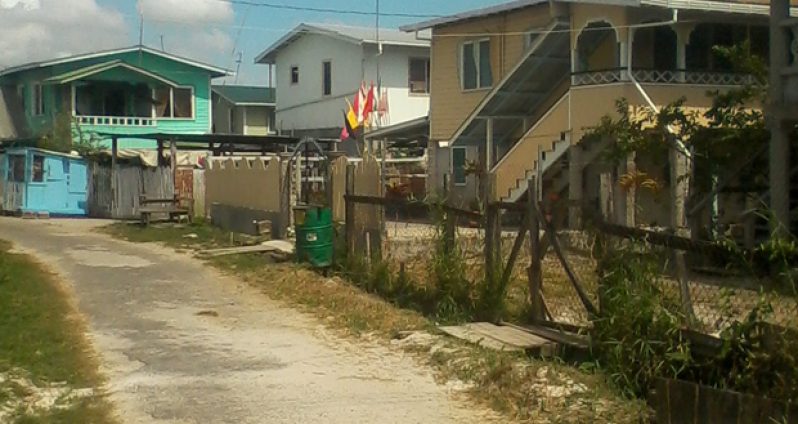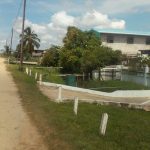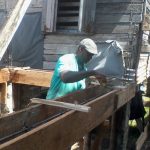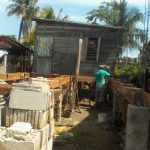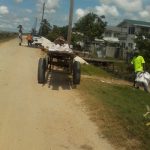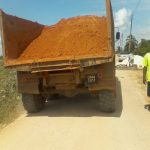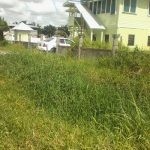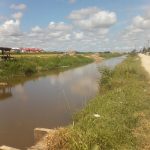IN every village we have visited before now, there was certainly the issue of personality clashes amongst residents, but this did not find footing in the very spectacular village of Goed Fortuin On the West Bank Demerara which was our focus of exploration this week.
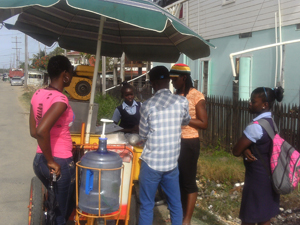
With its sandy streets and churning canals, the village exuded a certain breathtaking ‘Old World’ allure that seemed to blend quite nicely with the budding signs of economic development that are highly noticeable in the village.
What struck us the most and left a lasting impression, however, was the camaraderie amongst residents and the deep harmony they shared despite race, colour, class or creed.
It is expected that we would firstly acquaint ourselves with the location and other issues surrounding this village, so here we go folks…
Goed Fortuin of old
The words Goed Fortuin are Dutch words that mean ‘good’ and ‘fortune’ or ‘luck.’ Other similar Dutch names in Guyana are Goed Hope, Goed Raad, Goedland, and Goedverwagting.
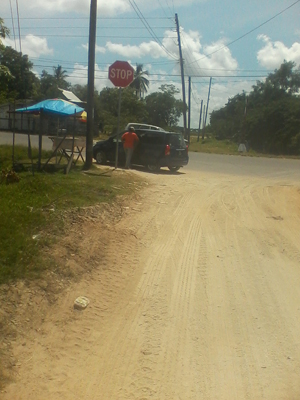
Sipora, one of the Mentawai islands in Indonesia, was named ‘Goed Fortuin’ by the Dutch.
Goed Fortuin village lies on the left bank of the Demerara River, and is 3 km or 2 miles from Vreed-en-Hoop. Its geographical coordinates are 58 12 W (Longitude) and 06 47 N (Latitude). The village was an old Dutch sugar plantation that started in the early 1800s when 380 sugar estates operated on the coast of the three colonies that would eventually unite to form British Guiana in 1831.
With the end of slavery in 1834, an apprenticeship programme was introduced to fill the labour scarcity. However, many apprentices abandoned the sugar estate life after their apprenticeship stint was over. This labour shortage, coupled with factors that impacted the price for sugar, caused many sugar estates to be sold at ridiculously low prices, as the owners simply wanted to get out of the business.
Between 1838 and 1846, nineteen sugar estates were sold at such low prices. In 1846 in particular, Plantations Haarlem (on the West Coast) and Goed Fortuin were sold for £3,500 and £1,700 respectively. The values of these two sugar estates during slavery were £50,000 and £35,000. Thus, Plantation Goed Fortuin was sold at less than 5% of its value when slavery was in full swing.
In 1829, there were 230 sugar plantations operating in the colony, owned by almost as many owners. In 1900, there were about 48 estates, and in 1958, just 18. Those estates (and there were many) that lacked efficiency and effectiveness of operations were forced into consolidation to meet strong competition and insecure markets. The
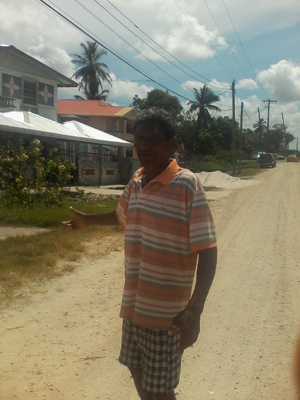
nearby Plantation Versailles stood out and grew by absorbing some of the smaller sugar estates, eventually amalgamating with Plantation Schoon Ord (south of Goed Fortuin) in the early 1950s, after which it came to be known as Pln. Versailles & Schoonord Estate Ltd.
Its major shareholder was Joseph (Joe) Vieira, one of the sons of the patriarch of Pln. Houston, Manoel Vieira (Buller), a pioneer of the sugar industry in Guyana, who was born in 1874 on the West Coast of Demerara. Joe spent almost seven decades in the industry, and used his experience and skills to bring much improvement not only to Plantation Houston and Versailles & Schoonord (which his family owned), but to other estates as well throughout the country. His son, Anthony Vieira, eventually took over as the Administrative Manager at Versailles until its closure in 1977.
The people
There was a strong influx of about 10,000 Portuguese in the year 1846-47 in the then British Guiana. Most settled in what is now Georgetown. The others settled on the sugar estates along the coast and banks of the Demerara River.
On the West Bank, they settled at Vreed-en-Hoop, Plantation Versailles, Pouderoyen, Goed Fortuin and a few other places along the river.
The emancipated slaves, shop owners, and others of Plantation Goed Fortuin settled along the main roadways, while the indentured immigrants from India settled behind the village in a nuclear housing scheme built by the owners of Plantation Versailles and Schoonord Estate in the early 1930s. Later, in the 1940s, this was expanded to include the area up to the ‘A’ line, the canal that separates Pln. Versailles from Goed Fortuin.
Thus, Goed Fortuin Housing Scheme provided the major labour supply for Versailles estate until 1977, when Versailles was permanently closed.
Goed Fortuin, in its heyday, had a vibrant Community Centre and a Primary School (the latter is still there). However, long gone are two logies that were situated at the very back and close to the sugar cane fields.
Dr Jung Bahadur Singh, father of cultural icon, Rajkumarie Singh and Dr Hardatt Singh, was born in Goed Fortuin. The elder Dr. Singh was elected in 1930 to the Legislature at national elections held that same year.
The visit
As I disembarked the bus at Goed Fortuin, I realised that exploring this village was not going to be an easy feat, judging from the bushy side streets and all the dust churned up in the streets from passing vehicles.
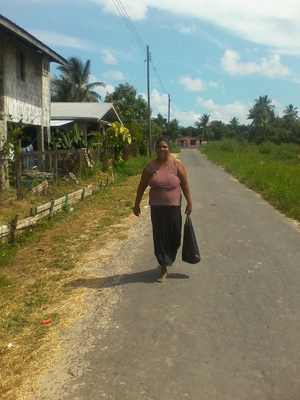
Barebacked little boys were chasing up and down the streets on bicycles in the broiling midday sun, and I was certainly appalled at the number of youths who were smoking cigarettes and what smelt like marijuana quite openly in public places.
The village is an exciting cluster of houses, and, judging from the striking variations in the buildings, it was evident that this village sported the lower, middle, and upper classes.
There were housewives darting in and out of shops, collecting their groceries, while a few were dashing barefooted through the alleyways, screaming to others that they had left their pots on the fire.
In some areas, men were just liming around, chatting about everyday issues, while in some areas, the youths scattered at the sight of our cameraman.
Investigations revealed that in many cases, they were either smoking or attempting to ingest illegal substances, and certainly did not welcome our intrusion.
The housewives speak
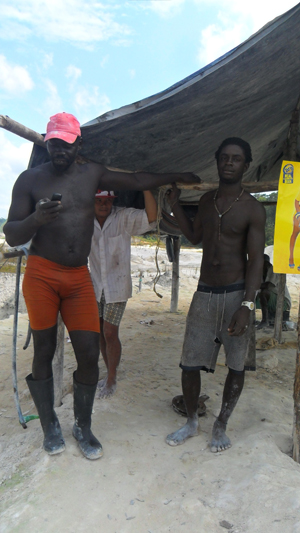
Those who were ready to talk were the housewives, since most of the males were either camera-shy or in some cases too drunk to say anything that made sense.
The ladies were certainly vocal, and voiced their opinions on issues they said were really bothering them.
According to Lolita Parsram, there is great need for “improvement and smoothing out” within the functions of the policing group that is intended to protect citizens.
“Sir, we got ah policing group heah, and it is ah total waste of time. Dem claim dem is ah policing group, and yet dem young bhais deh all ovah de place smoking weed and cigarettes in broad daylight. Dis group ain’t doing nothing, and at the pace dem young bhais going, it look like we gon surely get criminals in de village soon.”
According to the women, there seems to be a recent upsurge in smoking amongst males, some of whom are only sixteen years old; and, according to the ladies, many of them are consuming marijuana.
Stopping to chat with residents at the first house, a few males rose questioning eyebrows, but the two females there swinging in hammocks, were all welcoming smiles. One who appeared to be a grandmother mouthed with a toothless grin. “Good aftanoon uncle… wha wrang? How awe can help yuh?
Instantly my soul was at ease and with responding warmth I went into detailed explanation of the reason for my visit. Hearing this, the males seemed to get excited and two of them readily smoothed and fixed their apparel, offering to give us the grand tour of the small village.
At some homes we were greeted by smiling ‘camera shy women’ in their hammocks, some enjoying hot spicy lunches, which they seemed to be enjoying using their bare fingers. One very peppy grandmother, Meena Persaud explained that she certainly enjoyed mashing her food around her plate and putting into her mouth with her fingers. She claimed it was a traditional practice that was enjoyed by person in every home in the village.
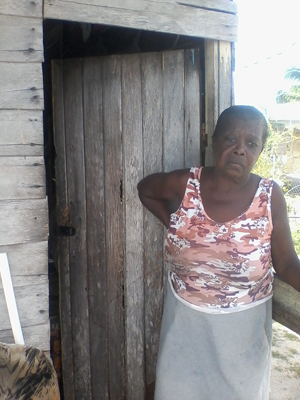
“Bai, me does really enjoy me food with me fingas. Is suh we does eat since we ah lil gals, and trust me, you does really enjoy de food more. De food does taste moh sweet, when yuh down, yuh can lie down and relax bettah”
This village is primarily an East Indian populated one where pleasant and jovial residents reside in perfect harmony. Villagers depend almost entirely on their rice farming and vegetable cultivation for existence.
Even as we drove around the village our tummies rumbled in anticipation at the appetising aromas of either deep fried or stewed fresh vegetables that bubbled on stoves and ‘cackling firesides.’
Some persons reared poultry which provided eggs and meat for consumption whilst a few strived on the rearing and sale of their very healthy cattle. Although there are quite a few grocery stores in the village, residents mentioned that they would normally journey to the nearby Vreed-en-Hoop Village or travel five miles to the Stabroek Market to obtain their groceries and household supplies.
Mothers busy flipping roti on their ‘tawahs’ or readying sweet smelling stews for lunch, indicated the village is engulfed most of the day in dust from vehicles traversing their unpaved streets, and the large trucks using the sand roads which pass just a few rods in front of the village.
Husbands chomping on ‘float bakes’ or ‘sada roti’ and fried salted fish, lamented that their children who attend school suffer the most since minibuses or cars hardly traverse the sand roads because of this condition.
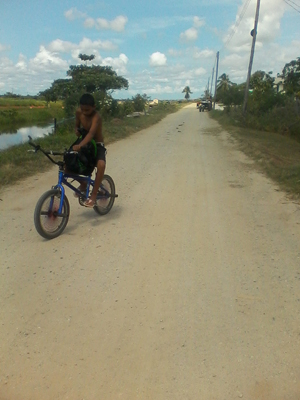
Residents adopt the ‘get up and get attitude’
All around Goed Fortuin it was a constant hustle and commercial bustle as villagers busied themselves with avenues of making a quick dollar, or meeting their needs otherwise. There were certainly no limers in this village and almost everyone seemed to be gainfully employed in some way or the other.
Around this time too many have obtained temporary employment as the way is being for the dawn of a new housing scheme, (just next door) made possible through government initiatives. A large number of villagers are employed at the Wales Sugar Estate, while some persons trade their produce at the Vreed-en-Hoop and Stabroek Markets.
Of course several villagers are employed at stores, shops and schools in and outside the village. Others have taken up positions in schools and offices in the city also.
To some extent too the bread winners of many homes provide for their family through the cultivation, harvesting, and sale of rice and vegetables from their farms.
Culture of the Village
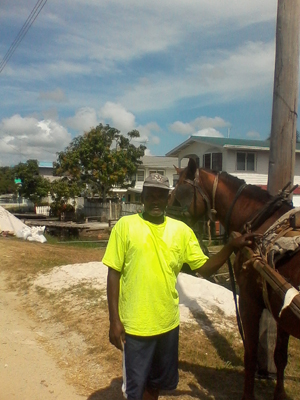
The culture in Goed Fortuin slightly resembles that of the Indian immigrants who came here 150 years ago. Even though well over 55% of the population remain Indo-Guyanese there is a small group of Chinese and Amerindian families. The culture is very similar to that of the rest of the British Caribbean, but with, according to the locals, an East Indian flair. The second biggest percentage of residents are the Negroes who reside the in peace and harmony with their neighbours
As history dictates, in the beginning, the culture of this village resembled very much that of the mother country, India, but as African and Chinese came to the village a slight variety was added. The residents of Goed Fortuin brought their foods, traditions, religion and customs with them. This is very prevalent today in the food and language of the people.
It is said that over the years, the population of Indians has lost their mother tongue completely, and although Indian music remains very popular, the English language, with a Creole touch, has taken complete control. Almost no one speaks Hindi anymore and in Goed Fortuin it is considered a dead language according to some residents. The colloquial English use is heavily influenced by the British. Being a colony for many years, Guyana is touched with a flair of British in almost everything
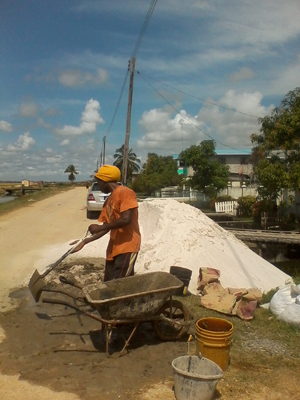
Even though the composition of the population has remained the same for over 45 years, the religious beliefs have changed dramatically. Regardless of religious conviction every holiday social or religious are celebrated and respected. Many of the customs that are objective and foster public life are commonly organized by community leaders at home and abroad.
Many of the original religious customs and traditions that have not been lost were modified by the ages and vestiges of an East Indian heritage appear in a number of the festivities. For example, few weddings are ever complete without the ceremonial rubbing of the dye; an old Indian wedding custom that is accepted among every religion. Holidays like Christmas and Diwali are examples of occasions where the entire community celebrates together in a congenial integration of faith.
Discoloured water
Another problem that seemed to be bothering these ‘goodly ladies’ was the issue of discoloured water flowing from the taps. While some said they try to manage, others said they refuse to drink the ‘red water’ and would normally purchase distilled water from the trucks or from the water plant some three villages away.
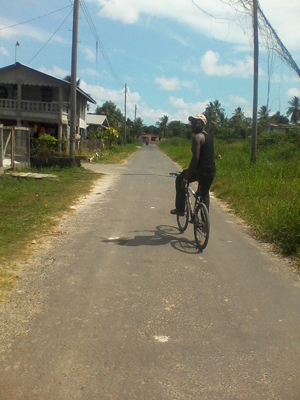
Some said they would use the water only for washing of coloured clothing and to water plants in some cases, since they are afraid to consume the liquid.
What struck us was the glaring fact that residents were faced with a serious garbage disposal problem, judging from the piles of refuse which seemed to be almost everywhere.
In some areas the piles consisted of rotting food, and the stench was intolerable, not to mention the large influx of flies and other vermin it lured to the village.
Cackling loudly as their anger boiled, housewives related that some residents in the village as well as outsiders would creep around in the still of the night, dumping garbage wherever they fancied.
Enquiries as to the functions of the Neighbourhood Democratic Council (NDC) were met with the rolling of eyeballs, mocking laughter, and snide remarks we had better not mention.
According to reports of villagers, the NDC would not come for months at a time to remove any garbage, and drains and trenches are left to become infested with weeds and other parasitic vegetation.
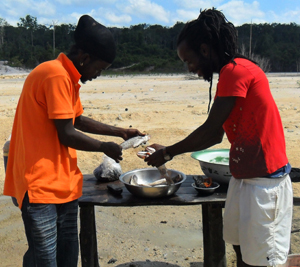
Such allegations were affirmed by the bushy, overgrown drains and large amount of ‘bushy groves’ and alleys in the village. Save for the main drainage canal just outside the village, which was in good shape, all other drains and small trenches in the village were ‘stuffed to capacity’ with weeds and foliage.
Villagers said that from time to time, they would have to engage in self-help efforts to prevent or alleviate flooding during the rainy seasons.
And many complained of the large clouds of dust that whirl through the village when vehicles attempt to venture in. This was caused because there is a housing scheme being built just next to the village, and the road that is being used by trucks taking sand and stone to that location is not asphalted.
Many females complained that the dust is causing ailments to their children, and would leave their homes covered in grime on a daily basis.
Livelihood
A large number of residents are self-employed in the village, and they seem to be comfortable with professions such as poultry farming. That aside, a large number of the males are employed at the Wales Sugar Estate, which offers varying employment opportunities.
Yes, indeed, there are a few teachers, and some occupying professions in the administrative offices outside of the village. Whatever their offices were, they all seemed to be contented, and surely appeared dedicated.
And we were lucky to talk to Raymond Moffat, self-employed poultry farmer and operator of a horse-drawn cart for over twenty-five years now. He was all smiles, and readily shared a little on the ups and downs of his job.
“I have been operating this horse cart for over 25 years now, and whilst it has profited me greatly, my gains do not come without gruelling work. I have to brave the scorching sun and sometimes heavy rain many times to do my errands to make a fast dollar. Sometimes I would go for hours in wet clothing.”
“And since I am also rearing my chickens now, it’s an uphill feat to manage smoothly with the two jobs.”
Raymond uses his horse cart to transport groceries and items of every imaginable nature for villagers, and charges them quite affordably for the service.
He takes great pride is talking about his ‘lovely chickens’, boasting that they matter in both size and quality.
“I take great pride in giving the best to my customers, so I feed my baby chicks well, with the best of food supplements, and watch them grow in fine style. My chickens can sometimes grow up to over seven pounds because I feed them well.
“And I love the satisfied smiles of my customers as they bicker in pleasure about the unusual size of my chickens.”
Harmony
This village may have its problems here and there, but what stood out distinctly was the camaraderie and strong bond of harmony that seemed to ooze out of villagers.
In the shops, the jolly banter of both races could be heard as housewives stock up on their household items. Same as in the way young girls were screaming at each other from open windows, begging the other to come over for a tasty lunch of curried hassa, or spicily stewed vegetables.
Yet again, the two races were having ‘a whale of a time’ enjoying drinks at the few rum shops, or just puffing cigarettes and chatting pleasantly under mango trees.
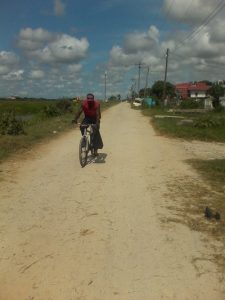
Everyone waved at and greeted each other, and most times stopped to enjoy the latest gossip or to make a point of importance on some issue in the village.
It was that deep sense of binding and harmonising that surely made me wish I was residing in this village.
And this quaint little location is well represented overseas, with the presence of the Goed Fortuin Cultural Society, which has been doing wonders for the village over the years.
The Goed Fortuin Cultural Society
The Goed Fortuin Cultural Society New York Chapter was born in the year 2004. It was conceived and seriously contemplated by a group of dedicated and committed individuals, who saw its absolute need as a medium to bring all past and present residents of their very beautiful Goed Fortuin, together to reminisce, to socialise, to reacquaint, and to take a much needed break away from the lifestyle of this country they now call home.
Special focus must be placed on these individuals: Mr. Khemraj Sukhu (Ram), Mr. Kawal Singh, Mr. Deonarine Bharrat (Dax), Mr. Shammi Ahmad, Mr. Jeremiah Somwaru (Uncle Jerry) and Mr. Patrick Ramcharran.
This Society was always a much-talked-about subject for many years, but never materialized because of a lack of commitment. Congratulations to all its members for their hard work and unwavering support, which brought much success to their subsequent events.
Goed Fortun is one of the dynamic locations in Guyana with, of course, an amazing story to tell. Be sure to drop by and mingle with the folks there if you should be in the area. Their hospitality would certainly blow you away
(By Alex Wayne)




.jpg)





